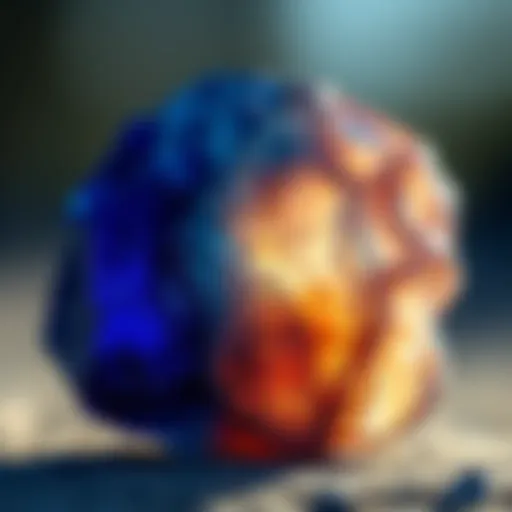The Importance of Quartz in Geological Formations
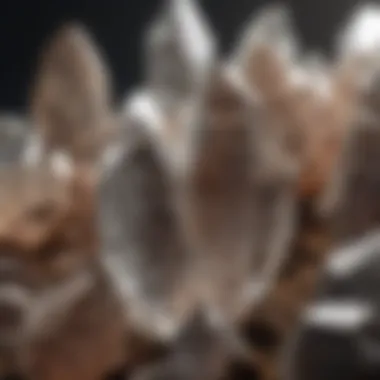

Intro
Quartz is one of the most abundant minerals found on Earth, and its presence within geological formations plays a pivotal role in shaping the characteristics of various rocks. The crystalline structure and chemical composition of quartz are not just essential for understanding the rock cycle but also for appreciating Earth's history. Throughout this article, we'll journey into the depths of quartz formation, how it's identified, and the significance it holds for both collectors and geologists alike.
The understanding of quartz reveals much about geological processes, especially regarding its metamorphic and sedimentary forms. Whether you consider yourself a dedicated collector or an enthusiastic geology buff, the intricacies of this mineral hold a treasure trove of insights.
Featured Collectible of the Month
Overview
This month, we highlight the mesmerizing Amethyst, a stunning variety of quartz known for its deep purple hues. Due to its aesthetic appeal and scarcity, Amethyst has made a name for itself among collectors and enthusiasts. This mineral not only charms with its beauty but also carries significant geological legacies. Found primarily in volcanic rocks or as nodules in sedimentary formations, Amethyst forms from the cooling of silicon-rich solutions, allowing us to trace the Earth’s cooling processes.
Collectors often seek out Amethyst geodes and crystal points, which can elevate their collections both in terms of visual appeal and geological value.
Historical Significance
Historically, Amethyst has been treasured for its beauty and supposed protective properties. Ancient Egyptians used it in jewelry, while Greek mythology spoke of its power to ward off intoxication. The allure of this mineral spans centuries, showcasing not only its geological significance but also its cultural value. In today’s world, collectors appreciate Amethyst for both its visual splendor and its crucial role in understanding the geological history of regions where it is found.
Identification Techniques
Visual Characteristics
When identifying quartz, particularly varieties like Amethyst, here are the key visual traits to look out for:
- Color: Clear quartz is generally colorless, whereas Amethyst exhibits rich violet purple shades.
- Luster: Quartz typically shows a vitreous (glass-like) luster that helps it to stand out in rock formations.
- Crystal Habit: Quartz forms hexagonal crystals, often seen in natural settings, which can help enthusiasts in identification.
Utilizing these characteristics allows collectors to distinguish between various types of quartz, enriching their collections with informed selections.
Resources for Identification
To enrich your understanding and identification skills, consider these resources:
- Wikipedia - Quartz
- Britannica - Quartz
- Reddit - Rock and Mineral Collecting Community
- Facebook - Crystal Collectors Group
These platforms are rife with knowledgeable communities excited to share tips and information, essential for both novice and experienced collectors.
"Quartz is more than just a mineral; it is a testament to the Earth's enduring processes and a window into its past."
As we dig deeper into the role of quartz, we will explore its formation processes, its relationship with other minerals, and how it impacts both geological structures and the fossilization timeline. The next section will exhibit how these formations tell the story of our planet's evolution over time.
Prelims to Quartz
Quartz is more than just a common mineral; it plays a crucial role in shaping our planet's geology. To understate its significance would be akin to overlooking the backbone of a well-structured building. This section introduces the multifaceted nature of quartz, essential for understanding both the physical attributes of rocks and the geological processes that govern Earth's landscape.
Definition and Composition
At its core, quartz is defined as a crystalline mineral composed of silicon and oxygen. The chemical formula, SiO2, seems simple but belies the complexity of its various forms. Derived from the Greek word for ‘shining’, quartz is often considered a true gem in the realm of geology.
It appears in a wide range of colors, textures, and habits, contributing to its diverse applications and importance in many realms, from construction to electronics. Quartz often accompanies other minerals, forming mixtures that alter its properties and potential uses. Its hardness, rating a solid seven on the Mohs scale, makes it resilient against weathering and erosion, allowing it to persist through time.
Crystallization Process
The process of quartz crystallization is a fascinating interplay of temperature and pressure. Generally, quartz forms from magma as it cools, or from hydrothermal fluids which may precipitate it out of solution in veins. This process can happen in numerous environments, from deep within the Earth’s crust to the surface.
During crystallization, silicon and oxygen atoms join in a repeating pattern, creating the structured lattice typical of quartz crystals. The conditions under which this occurs greatly influence the final appearance of the quartz. For example, rapid cooling in volcanic environments can lead to tiny, clear crystals, whereas slower cooling can yield larger, well-formed specimens.
Understanding the crystallization process is vital for geologists and collectors alike, as it holds the key to knowing where to find high-quality quartz specimens. Whether examining the glimmering facets of a quartz crystal or the subtle hues of its varied types, grasping the fundamentals of how quartz forms enhances appreciation for this remarkable mineral.
The Occurrence of Quartz in Different Rocks
Quartz is a cornerstone in the geological composition of the Earth. To fully grasp its significance, one must understand how it manifests across various types of rocks—igneous, sedimentary, and metamorphic. Each of these rock categories showcases the versatility and resilience of quartz, illustrating its multifaceted role in geological formations. The presence of quartz not only enhances the durability of rock structures but also plays a crucial part in tectonic activities and environmental interactions.
By examining quartz in these different contexts, we gain insights into Earth's history and the processes that shape its surface. This exploration serves not only geologists but also collectors who appreciate the beauty and resilience of quartz across various formations.
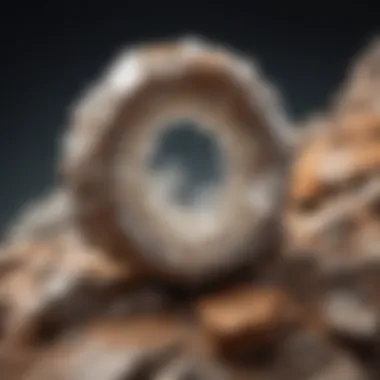

Igneous Rocks
Igneous rocks form through the cooling and solidification of molten material, known as magma. Quartz, with its high melting point, often crystallizes within these rocks as they cool. You'll find quartz in both intrusive and extrusive igneous formations. In intrusive rocks like granite, quartz typically appears as large, well-formed crystals, tangled with other minerals like feldspar and mica. Conversely, in volcanic rocks such as rhyolite, quartz may be present as smaller, less distinct grains.
The distinctive traits of quartz contribute to the overall aesthetic of igneous rocks. For example, when weathered, granite exhibits a magnificent sparkle due to the quartz crystals reflecting light. Collectors often seek out these formations for their beauty and indicative mineral composition, which tells a story of the magma environment, depth, and cooling rate. The robustness of quartz in igneous settings also means that it can withstand weathering and erosion much better than many other minerals, making it a dominant player in the formation of sediment.
Sedimentary Rocks
In the realm of sedimentary rocks, quartz takes on yet another role. These rocks form from the accumulation and compression of mineral and organic particles, including those that have weathered from igneous rocks. Quartz is incredibly resistant to chemical weathering. Therefore, it tends to remain intact while other minerals break down. This durability means quartz can dominate sedimentary rocks, often being the primary constituent of sandstone.
Sandstone can vary greatly in color and composition, but the presence of quartz adds a certain uniformity and stability. Many notable geological formations, such as the Navajo Sandstone in Utah, showcase massive quartz-rich layers that have stood the test of time. For collectors, sedimentary quartz is significant not only for its physical properties but also for its historical implications—it often holds unique fossils or ecological records that reveal ancient environments.
Metamorphic Rocks
Metamorphic rocks are products of heat and pressure, where existing rocks transform into new forms. During this metamorphic process, quartz is not just preserved but can also grow larger or change in arrangement, particularly in rocks like quartzite, which is a metamorphosed version of sandstone. Quartzite, characterized by its impressive hardness, is mostly composed of fused quartz grains, making it highly sought after for both landscaping and ornamental purposes.
Quartz’s ability to survive the metamorphic process positions it as a resilient mineral. Its presence in metamorphic rocks indicates the conditions under which the rock formed, opening windows into geological history. Collecting quartzite can provide insights into past landscapes, revealing how environments were altered over millions of years. The texture and color variations found in metamorphic quartz make it a unique finds for enthusiasts, reflecting not just beauty but a narrative of transformation.
Quartz is more than just a mineral; it embodies the Earth’s history and geological processes across different rock types.
Quartz Varieties and Their Characteristics
Understanding the different varieties of quartz is key to appreciating its role in geological formations. Each type exhibits unique characteristics that not only influence their use but also provide insights into the conditions under which they formed. The variations among quartz types can indicate the geological history of their environments, making them invaluable to collectors and geologists alike.
Common Quartz Types
Amethyst
Amethyst is a striking variety known for its beautiful purple hue. This gemstone is a member of the quartz family, and its color comes from iron impurities within the crystal structure, which is quite fascinating. Amethyst is considered a birthstone and holds significant cultural and aesthetic value, making it a popular choice among rock and fossil collectors.
The unique feature of amethyst lies in its color zoning—often, hues can range from light lavender to a deep royal purple. This variability enhances its desirability, despite the fact that deeper colors are rarer and, thus, fetch a higher price. One downside, however, is that prolonged exposure to sunlight can cause amethyst to lose its color, which may not be ideal for display in bright environments.
Citrine
Citrine, distinguished by its warm yellow to golden color, is often referred to as the "merchant's stone" for its reputed ability to attract wealth and prosperity. The key characteristic of citrine is its rarity compared to its more abundant relative, amethyst. Natural citrine is quite rare; most available on the market is heat-treated amethyst, which is a lesser-known fact.
Citrine's unique feature is its transparency and bright, sunny color that can uplift the spirit, making it a desirable choice for jewelry and decorative items. Its hardness makes it durable, but one must also consider that heat-treated stones may not have the same energetic properties that appeal to some collectors.
Rose Quartz
Rose quartz is adored for its gentle pink color and is often linked to unconditional love and compassion. Its soft hue is a key characteristic, making it a favorite among those looking to add a touch of romance to their collection. The stone's translucent quality offers a lovely aesthetic, enhancing its popularity in both jewelry and crafts.
A unique aspect of rose quartz is that it is somewhat more abundant than other varieties, so collectors can often find larger pieces without breaking the bank. On the downside, its softness (although still classified as quartz) makes it susceptible to scratches and chips, which can compromise its beauty.
Smoky Quartz
Smoky quartz displays a beautiful range of earth tones, from light gray to deep brown. This quartz type is often seen as grounding and protective, which adds to its allure. The smoking effect, which gives it its name, occurs due to natural radiation in the environment, leading to fascinating crystal formations.
The key characteristic of smoky quartz is its striking appearance and perceived protective properties, which are why it is favored in various spiritual practices. Smoky quartz also tends to be more resistant to damage compared to other varieties due to its slightly higher hardness. However, its darker shades can make it less appealing for brightness in decor, which some collectors may want to consider.
Physical Properties
Hardness
Quartz is rated at 7 on the Mohs scale of hardness, which makes it relatively resistant to scratches and damage. This characteristic is vital because it allows quartz, in its various forms, to endure the test of time and survive natural erosion processes. This durability is a significant point of advantage for collectors and geologists who encounter quartz in various forms in the field.
Clarity
The clarity of quartz can vary significantly from one specimen to another. While some quartz varieties are nearly transparent, others possess numerous inclusions or cloudiness, which can affect their desirability. Clear quartz is particularly valued in healing practices and jewelry, while formations with inclusions can offer insights into the geological history of the area they hail from. Clear quartz is often regarded as a powerful amplifying crystal, which gives it an edge in various applications.
Color Variability
One of the fascinating aspects of quartz is its wide range of colors due to the presence of various trace elements. This variability allows for the classification of quartz into many types, each with distinctive appearances. While collectors appreciate color variations, certain hues can also be indicative of the environmental conditions under which the quartz formed, offering key insights into geological processes. A notable challenge is that color can be subjective; what one collector finds stunning, another might not prioritize.
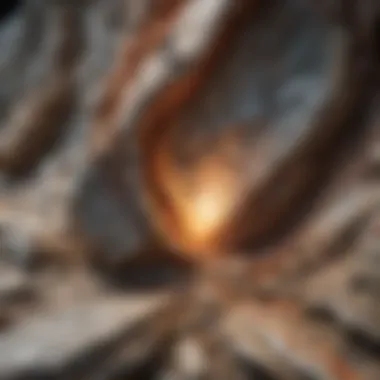

The understanding of quartz varieties and their characteristics helps unravel the layered complexity of geological formations, forming a bridge between mineralogy and history.
Quartz in Geological Processes
Quartz plays a pivotal role in the geological processes that shape our planet. Being one of the most abundant minerals, it significantly influences the physical and chemical landscape of geological formations. Understanding how quartz interacts with its environment offers valuable insights into the processes behind rock formation, sediment dynamics, and even earth's evolutionary timeline. Its strength and durability make it an essential component of the Earth's crust, which in turn affects erosion patterns and sediment transport. Moreover, its interactions with other minerals further enhance geological diversity.
Role in Weathering
Weathering, the process whereby rocks break down due to environmental factors, is where quartz demonstrates its resilience. Unlike softer minerals, quartz withstands weathering, maintaining its integrity throughout. This durability allows quartz to persist even as surrounding minerals crumble away. The effects of weathering can be seen in various landscapes:
- Physical Weathering: Abrasion from wind or water can round off quartz grains, leading to smooth, shiny surfaces known as quartz pebbles.
- Chemical Weathering: When exposed to acids in the environment, quartz is less likely to dissolve, owing to its chemical stability. This characteristic renders quartz sediments abundant in soil profiles, especially in arid and nutrient-poor regions.
Thus, quartz acts not merely as a survivor in the face of the elements, but as a marker of geological history, informing geologists about past environments.
Influence on Erosion
Erosion, the process of material removal from one location and its deposition in another, greatly benefits from the presence of quartz. Its hard nature means quartz grains are often contributed to the sediment load in rivers and streams. As these quartz particles are carried along by flowing water, they can:
- Impact riverbed morphology, contributing to stream channel stability.
- Affect sediment transport rates by being more easily eroded and transported compared to less durable minerals.
Additionally, quartz sands often provide essential features in coastal and riverine systems, promoting habitats and protecting shorelines from rapid erosion. The way quartz interacts with water also plays a central role in shaping landscapes, guiding how sediment is deposited and forming intricate geological structures.
Interaction with Other Minerals
Quartz does not exist in isolation. Its presence often indicates complex interactions with other minerals within the geological spectrum. This symbiosis can be witnessed in various settings:
- Granite Formation: In igneous formations, quartz coexists with feldspar and mica, creating a visual mosaic that reveals the conditions under which the rocks formed.
- Metamorphic Rocks: In metamorphism, quartz can influence the crystallization of other minerals, affecting the overall composition and texture of the rock. For example, in schist, quartz can bond with garnet and other minerals to create a metamorphic texture that reflects the intense pressures involved. This interplay is vital for both aesthetic value and functional strength.
In summary, quartz serves as a cornerstone in the geological processes, influencing weathering, driving erosion patterns, and fostering relationships with other minerals. Its robust and versatile nature allows it to shape landscapes while simultaneously serving as an indicator of Earth's geological past. Understanding these relationships provides crucial insights into both past and future geological events.
Identification Techniques for Quartz in Fieldwork
Identifying quartz in the field is often the first step for rock and fossil collectors looking to understand geological formations. Knowing which techniques to use can save time and lead to more accurate results when sorting through samples. Two primary methods stand out when it comes to identifying quartz: visual identification and chemical tests. Each method has its own strengths and considerations, which are essential for a thorough understanding.
Visual Identification
Visual identification of quartz might seem straightforward, yet it carries a wealth of nuances that a trained eye can appreciate. Color, clarity, and shape play significant roles in distinguishing quartz from other minerals. Most quartz varieties, like amethyst or citrine, exhibit distinctive colors stemming from trace elements or radiation exposure.
Here are essential characteristics to look out for:
- Luster: Quartz typically has a glassy sheen due to its crystalline structure. This helps differentiate it from dull minerals.
- Hardness: Quartz ranks at 7 on the Mohs scale. It won't scratch easily, which is a handy trait when examining pieces.
- Crystal habit: Its hexagonal prism shape is unmistakable. Additionally, look for terminated crystals, which indicate well-formed internal structures.
Sometimes, lighting matters too. Natural sunlight may showcase internal fractures and inclusions, helping collectors spot quartz beneath a layer of dirt or rock.
"The visual traits of quartz are not just for identification; they tell stories of their formation, revealing age and environmental conditions."
Using a magnifying glass can also be a game-changer. This tool allows for close examination of any imperfections or growth patterns, uncovering the tale behind the mineral’s journey.
Chemical Tests
While visual identification can be sufficient, incorporating chemical tests adds another layer of certainty. Simple field tests can help confirm quartz and differentiate it from similar minerals like feldspar or calcite. Here are a couple of tests to consider:
- Acid Test: A drop of hydrochloric acid on a suspected calcite will fizz due to the reaction. Quartz, however, is non-reactive. If no fizzing occurs, you might just be looking at quartz.
- Streak Test: Rubbing the mineral against unglazed porcelain can yield a streak color. Quartz generally leaves a colorless streak. If there's any color, you should investigate further.
Remember, these tests are not foolproof but can guide you in the right direction. Carrying basic test kits on field trips could be particularly useful, but ensure you're cautious about the application of any chemicals.
The Importance of Quartz in Fossilization
Fossilization is a remarkable process that allows us to glimpse into Earth’s past, capturing a slice of life that would otherwise fade into eternity. Quartz plays a crucial role in this intricate dance of preservation. Understanding quartz's significance in fossilization enriches not only our knowledge of geological formations but also aids collectors and scientists alike in deciphering ancient ecosystems.
Quartz as a Preservative Agent
Quartz is known for its durability and resistance to weathering, which makes it an effective preservative agent during the fossilization process. When organisms die and become buried under layers of sediment, quartz particles can infiltrate and fill the spaces left behind. This process is known as permineralization.
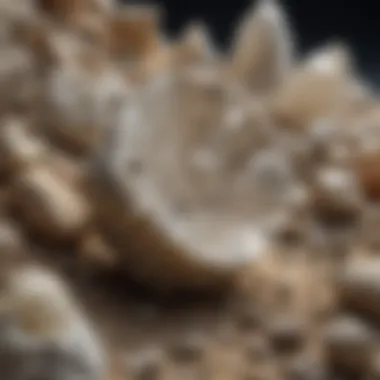

- Structural Integrity: The presence of quartz contributes to the structural integrity of fossils. Since quartz is a hard mineral, it withstands erosive forces, ensuring that fossil remains can endure through geological time without disintegrating.
- Minimizing Decomposition: Quartz helps create an environment that minimizes organic decomposition. Its presence limits the movement of water and air which are necessary for bacteria and fungi to break down organic materials.
- Formation of Casts and Molds: In scenarios where organisms decay completely, the spaces they occupied may be filled with quartz sediments. This leads to the formation of casts and molds that replicate the original structures of the organisms.
Essentially, quartz acts like a time capsule, preserving details about life forms that existed long ago, including their morphology and sometimes their chemical signatures.
Impact on Sediment Compaction
The impact of quartz on sediment compaction is another crucial aspect related to fossilization. As sediments accumulate over time, the weight of the overlying material compresses the layers beneath it. Quartz contributes to how these layers compact and concentrates pressure, which has significant implications for fossil preservation.
- Effective Compactor: Unlike softer minerals, which might flake or powder under pressure, quartz provides a stable framework. This stability facilitates a uniform compaction of the sediment layers, which helps maintain the integrity of the fossils within them.
- Porosity Improvement: Another consideration is the porous nature of many sedimentary formations containing quartz. The spaces created by quartz grains allow for the filtration of groundwater, which is essential for mineral deposition around fossilized remains, further solidifying their structures.
In summary, the function of quartz in fossilization extends beyond being merely a participant in geological formations. It acts as a guardian of historical life, influencing the efficacy of preservation and the geological context in which fossils are found. By understanding these roles, collectors can better appreciate the artifacts of nature they seek, while researchers can deepen their exploration of ancient life and environments.
Quartz not only preserves the past but also unravels clarity in the history of life on Earth.
By highlighting these roles, we can see quartz not only as a beautiful mineral but as a cornerstone of geological and paleontological studies, essential for those who wish to uncover the mysteries of our planet's history.
Cultural and Economic Significance of Quartz
Quartz has long been an integral part of human culture and economy. Its presence is felt not only in geological frameworks but also in art, décor, and various industries, making it a multifaceted mineral that transcends mere geological interest. From antiques to cutting-edge technology, quartz plays a significant role in defining our aesthetic and practical engagements with the natural world.
Quartz in Jewelry and Ornamentation
Jewelry crafted from quartz takes many forms, ranging from the delicate allure of amethyst to the refreshing shade of green found in prehnite. Each type of quartz carries its own unique symbolism and appeal, often chosen for its color or perceived metaphysical properties. For example, rose quartz is deemed the stone of love, while citrine is associated with prosperity.
The aesthetics of quartz are undeniable, and the craftsmanship that goes into creating these pieces can vary. Custom-made jewelry can fetch a pretty penny, as collectors and hobbyists alike seek out unique stones with specific hues and clarity. From bracelets to necklaces, quartz is often the go-to choice for creating versatile and attractive pieces. The versatility extends to its durability, being harder than many other gemstones, which means it withstands everyday wear better than softer stones.
"Quartz is often the go-to choice in jewelry, both for its beauty and durability."
Moreover, its significance stretches beyond ornamentation; many cultures utilize quartz in spiritual practices and traditions. Some believe that certain quartz varieties can enhance the wearer’s abilities or provide protection. This blend of aesthetic value and cultural belief makes quartz not just a stone, but a vessel of human expression.
Industrial Uses
Quartz is much more than a stunning gemstone. Its physical properties make it an essential material in various industrial applications. The following areas highlight its importance:
Electronics
In the electronic realm, quartz plays a pivotal role, particularly in the production of watches and the regulation of electronic signals. Quartz crystals oscillate at specific frequencies when subjected to electric fields, making them perfect for maintaining accurate time in wristwatches and clocks. This property enables numerous electronic devices, including smartphones and radios, to function efficiently.
Moreover, because quartz is abundant and can be engineered to precise specifications, it’s cost-effective yet high-quality, contributing significantly to its wide acceptance in the electronics sector.
Optics
The optical properties of quartz cannot be overstated. Its ability to transmit light while refracting it effectively makes quartz a fundamental component in lenses for cameras, microscopes, and telescopes. Certain types of quartz, like crystalline quartz, can even polarize light, adding to their utility in optical instruments.
In many cases, quartz lenses offer clarity and durability that surpass other materials, making them a preferred choice in high-performance optics. However, the process of working with quartz can be in-depth, often requiring specialist equipment and techniques to shape and polish it without sacrificing its inherent quality.
Construction
In construction, quartz has found its way into countertops, tiles, and various architectural applications. Synthetic quartz surfaces are popular for their non-porous nature, meaning they resist stains and bacteria better than natural stone alternatives. This feature not only meets health and safety standards but also makes for easier maintenance in both residential and commercial spaces.
Furthermore, the availability of various colors and designs makes quartz a sought-after choice for modern architecture. While inexpensive alternatives exist, the durability and aesthetic qualities of quartz often outweigh initial cost concerns for those seeking long-lasting beauty.
Epilogue: The Multifaceted Role of Quartz
Quartz doesn’t just sit pretty in geological formations; it plays a huge part in the story of our planet’s history. From the smallest sand grains to the grandest mountain ranges, quartz influences the way we understand Earth. The different roles that quartz takes on are like different faces of a coin, each reflecting unique facets of Earth's processes.
Summary of Key Points
In wrapping things up, it's important to highlight several key aspects of quartz and its diverse functions in geology:
- Foundational Element: Quartz makes up a significant part of many rock types, providing stability and resilience in the face of natural forces.
- Weathering and Erosion: Quartz is notably resistant to weathering. Its durability means that while other minerals may dissolve or wear away, quartz can persist, shaping landscapes over time.
- Fossilization Aid: Acting as a preservative agent, quartz works with sediments to protect and maintain ancient biological matter, which helps paleontologists understand life from millions of years ago.
- Cultural and Economic Value: Beyond the earth's crust, quartz has nestled its way into art, industry, and technology—showcasing its multifaceted relevance.
"Quartz stands as more than just a common mineral; it is pivotal in molding the physical and cultural landscapes of our world."
Future Directions in Quartz Research
Looking ahead, researchers are keen on peeling back more of the layers surrounding quartz. Some intriguing areas of study might include:
- Nano-Quartz: Investigations into nano-sized quartz particles may provide insights into their unique properties and potential applications in nanotechnology.
- Environmental Impact Studies: As quartz is used in fracking and other industrial processes, understanding its environmental implications in these contexts will become increasingly critical.
- Quartz in Climate Studies: Researchers could explore how quartz weathering contributes to carbon cycles and impacts climate change over prolonged periods.
- Geological Mapping: Advancements in mapping technologies may lead to better identification and analysis of quartz deposits, revealing their distribution in unexplored terrains.
In summary, the role played by quartz transcends mere geological context; it is fundamentally interwoven with the processes that shape our planet. With ongoing research, we are bound to uncover greater complexities, offering enlightening perspectives on this essential mineral.



